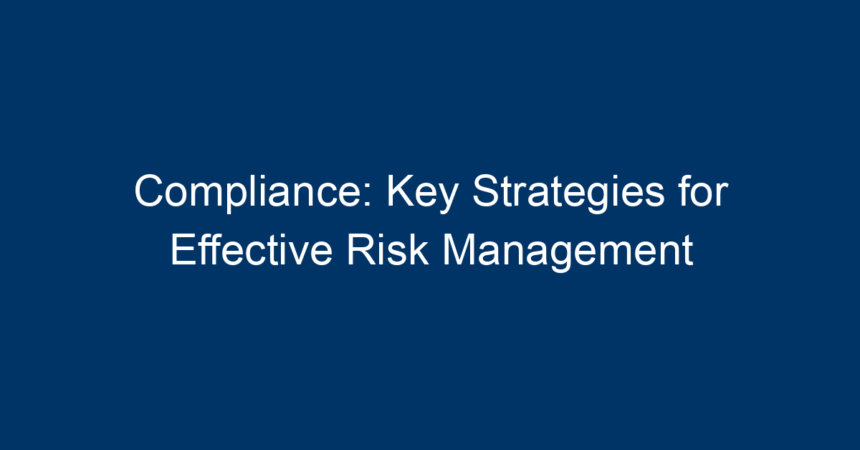In today’s dynamic business landscape, compliance has emerged as a cornerstone for successful risk management. Organizations face a myriad of regulations and standards that govern their operations, making it imperative to adopt effective compliance strategies. This article explores key strategies for compliance that can significantly enhance risk management processes. By weaving compliance into the very fabric of your organization, you can not only mitigate risks but also foster a culture of integrity and accountability.
Understanding Compliance and Risk Management
Compliance refers to the adherence to laws, regulations, and internal policies that govern an organization. It encompasses a wide range of requirements, from data protection laws to industry-specific regulations. On the other hand, risk management is the proactive identification, assessment, and prioritization of risks followed by the implementation of strategies to control, minimize, or eliminate those risks.
The Interconnection between Compliance and Risk Management
Effective risk management cannot exist in a vacuum; compliance is its foundation. For instance, organizations that fail to comply with regulations expose themselves to fines, lawsuits, and reputational damage. By integrating compliance into risk management frameworks, businesses can identify potential regulatory pitfalls early and take action to resolve them.
Key Strategies for Effective Compliance
1. Establish a Compliance Framework
A thorough compliance framework is essential for managing risk effectively. This framework should include:
- Policies and Procedures: Document the organization’s approach to compliance in clear, concise policies. These should outline the expectations and responsibilities of employees at all levels.
- Code of Conduct: Develop a comprehensive code of conduct that reflects the organization’s values and commitment to compliance. This document should be actionable and provide guidelines for ethical decision-making.
2. Conduct Regular Risk Assessments
Regular risk assessments are crucial for identifying potential compliance risks. Consider the following steps:
- Identify Risks: Gather a cross-functional team to identify compliance-related risks specific to your industry and organization.
- Analyze Risks: Assess the likelihood and impact of these risks. Prioritize them based on their potential effect on the business.
- Review and Revise: Compliance regulations and risks evolve. Periodic reviews ensure that your compliance measures remain effective and relevant.
3. Train Employees
Employee training is a fundamental aspect of any compliance program. It ensures that staff members understand their roles and responsibilities regarding compliance. Consider these training tips:
- Tailor Training Programs: Customize training based on the specific needs of different departments within the organization.
- Utilize E-Learning: Incorporate e-learning platforms for flexibility and to easily track employee progress.
- Continuous Education: Promote a culture of ongoing education about compliance and risk management to keep staff informed about changes in regulations and best practices.
4. Implement Monitoring and Reporting Mechanisms
Monitoring compliance is vital to ensure that policies and procedures are followed. Implement effective monitoring and reporting mechanisms:
- Internal Audits: Schedule regular internal audits to assess compliance with established policies and procedures.
- Anonymous Reporting Channels: Create a safe environment for employees to report compliance violations without fear of retaliation. This can be facilitated through anonymous hotlines or digital platforms.
5. Foster a Culture of Compliance
Creating a culture of compliance within your organization is key to effective risk management. Steps to consider include:
- Leadership Commitment: Management should lead by example, demonstrating a strong commitment to compliance through their actions and decisions.
- Engagement Opportunities: Encourage employees to engage with compliance initiatives. This can be achieved through workshops, discussions, and feedback sessions.
- Recognition Programs: Acknowledge and reward compliance champions within the organization. This encourages other employees to adopt compliant behaviors.
6. Leverage Technology
In today’s digital age, technology plays a significant role in enhancing compliance efforts. Here’s how technology can support your compliance initiatives:
- Compliance Management Software: Invest in platforms that automate compliance tracking, documentation, and reporting to streamline processes and reduce human error.
- Data Analytics: Utilize data analytics to monitor compliance metrics and gain insights into potential areas of risk.
- Artificial Intelligence (AI): Explore AI solutions for real-time risk assessments and predictions based on historical data.
The Importance of Adaptability
Staying Agile in Compliance
Regulatory environments are constantly changing. Organizations must remain agile in their compliance approaches to adapt to new requirements and challenges. Strategies to stay adaptable include:
- Market Research: Regularly conduct market research to stay informed about emerging regulations and industry standards.
- Collaborate with Industry Experts: Engage with legal and compliance experts who can provide insights into best practices and evolving regulations.
- Participate in Industry Groups: Join professional associations or groups specifically focused on compliance and risk management. This can foster collaboration and knowledge-sharing.
Actionable Insights for Implementation
-
Develop a Clear Compliance Strategy: Start by creating a detailed compliance strategy that aligns with your organizational goals and risk profile. Ensure that it’s communicated at all levels.
-
Prioritize Training Initiatives: Make compliance training a fundamental part of your onboarding process and an integral aspect of ongoing employee development.
-
Utilize Analytics and Metrics: Regularly analyze compliance data and metrics to identify trends and make informed decisions regarding compliance improvements.
-
Engage Employees: Foster a two-way communication channel where employees feel comfortable discussing compliance-related concerns. Their insights can provide crucial information about potential compliance shortcomings.
- Review and Optimize: Schedule regular reviews of your compliance framework. Use employee feedback and audit findings to make necessary adjustments to policies and procedures.
Conclusion
In conclusion, effective compliance strategies are imperative for successful risk management. By establishing a solid compliance framework, conducting regular risk assessments, training employees, and leveraging technology, organizations can navigate the complexities of compliance while mitigating potential risks. A commitment to creating a culture of compliance not only protects the organization but also cultivates trust among stakeholders.
To thrive in a regulatory landscape that is continually evolving, businesses must remain agile and proactive. With these actionable insights, you can enhance your compliance efforts and position your organization for success in the future. Compliance is not just a necessity; it’s a strategic advantage in today’s competitive environment.




